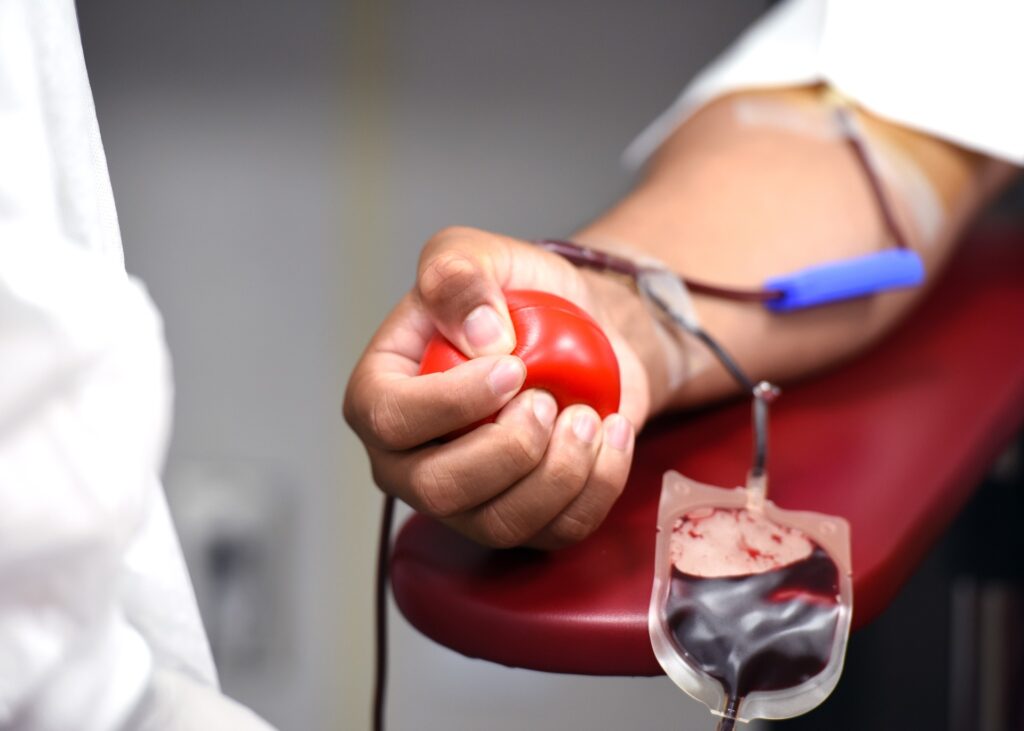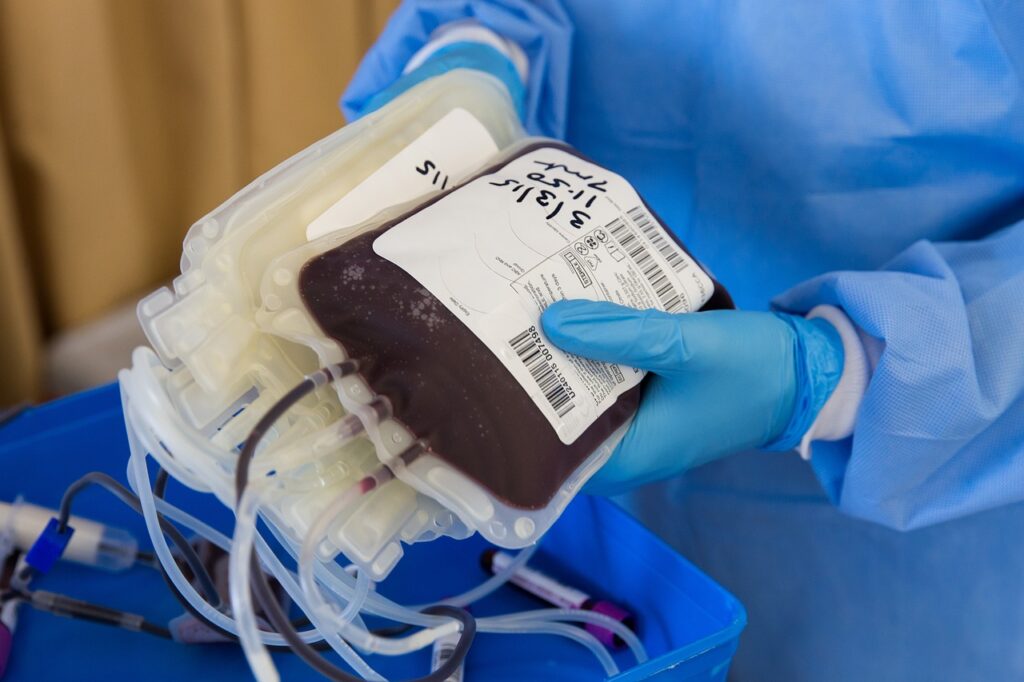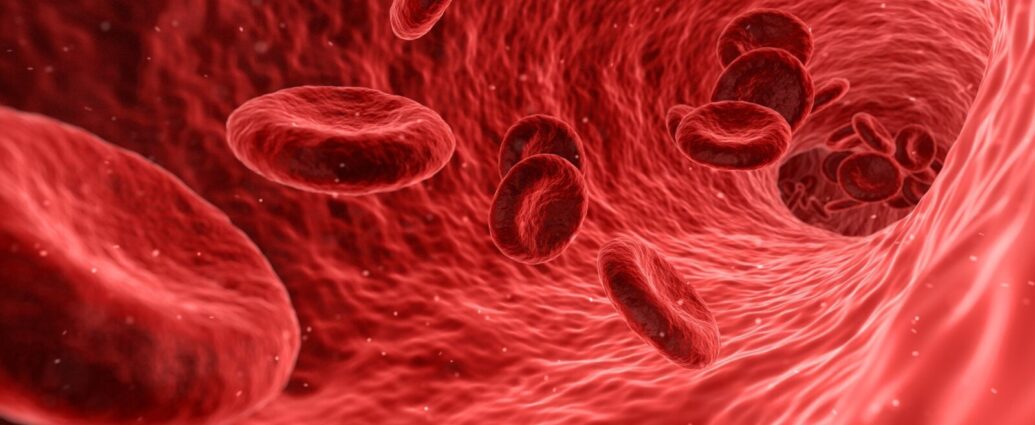(CW: Images of blood, needles, and medical procedures.)
April Lloyd
Ever wondered what it’s like to give blood donations on prescription? Honestly, up until the last year, I certainly didn’t. Now I’m on orders to donate for my health.
When Blood Donation Is Just What the Doctor Ordered
I couldn’t help but laugh at the irony of blood donation, rolling up my sleeve last Halloween to give vampires a pint of the good stuff.
But let’s get this out in the open: blood donation is a beautiful thing to do. It saves lives, my mum’s and my husband’s included. That’s one reason I donated blood at university. The second is that I’m deathly afraid of blood.
After all, what better means of facing your fears than popping into a blood bank?
“But never mind the biccies: I was there on doctor’s orders”
So there I was, in Liverpool St. Paul’s donation centre on Halloween, joining volunteers as they lined up to give fresh pints of blood to those in need. Beds were full, which is hardly surprising given the amber alert surrounding low blood supplies. Nurses gave out blood-red drinks to hydrate willing donors. The biscuits beckoned, promising sweet rewards once the deed was done.
But never mind the biccies – I was there on doctor’s orders. I was born with type 1 genetic haemochromatosis.
Haemochroma-what?
I won’t deny the name is certainly a tongue-twister. Haemochromatosis is an almost supercalifragilistic medical condition. The long and short of it is my body is greedy when absorbing iron from food. I was diagnosed in September 2022, after a decade of being a “hypochondriac” and “whinging” about aching joints, irregular periods, and discoloured knuckles.
What is Haemochromatosis?
Haemochromatosis (HH) is a genetic disorder causing the body to absorb excessive iron. Iron is necessary to live, as this nutrient feeds and sustains our cells. However, those with hereditary haemochromatosis absorb four times as much iron as we should.
Your body has no natural way of depositing iron other than menstruation, so the excess is transported from your blood to major organs and joints. So if there’s one thing I can thank my period for – it’s for lowering my iron level.
The symptoms of haemochromatosis are often overlooked or misdiagnosed, but haemochromatosis is extremely common, especially in the UK. Without treatment, haemochromatosis takes its toll. When your body absorbs too much iron, as many people with haemochromatosis do, you develop iron overload.
Haemochromatosis is often referred to as a ‘stealth disease’. This is because, in the early stages of iron overload, symptoms appear largely generic:
- Fatigue
- Brain fog
- Mood swings
- Bruising
- Shortness of breath
- Joint pains, especially in the fingers
- Inability to maintain an erection
- Irregular, heavy, or absent periods
But, as it progresses, haemochromatosis can develop into much more distinct symptoms:
- Decreased libido
- Darkening or discolouration of the skin (you may look ‘permanently tanned’)
- Tummy pain
- Slow healing
- Jaundice
- Extreme thirst
- Chest pain
- Arrhythmia
- Liver, heart, and pancreatic cancers
The age and gender gaps for diagnosis are significant. Cisgender men and transgender women statistically receive a diagnosis in their early 40s. Meanwhile, haemochromatosis is often left undetected in cisgender women and transgender men.
Left undetected, iron overload can be fatal. You cannot develop or catch it – it’s all in your genes. You also cannot fight off haemochromatosis through diet alone. That said, eating healthy and taking out foods rich in haem iron is helpful.
How common is haemochromatosis?
Haemochromatosis is not rare. Nicknamed ‘The Celtic Curse’, haemochromatosis is the UK’s most common genetic disorder. It affects at least 380,000 people in the UK and even those numbers are considered conservative estimates.
According to NHS records, just 5,000 individuals in the UK hold an official diagnosis. Also, haemochromatosis is not always on a GP surgery’s radar and is not always included in medical training.
There are different gene pairings associated with haemochromatosis. Each pairing comes with its risk of overload. There are thousands of potential combinations, but these four are the most common:
- Compound homozygous (C282y + C282y): Has haemochromatosis – High risk of overload.
- Compound heterozygous (C282y + H63d): Has haemochromatosis – Moderate risk of overload.
- Compound homozygous (H63d + H63d): Has haemochromatosis – Low risk of overload.
- Carriers (One C282y gene or one H63d gene): Unlikely haemochromatosis – Fractional risk of overload.

Despite these low numbers, the NHS reports at least 1 in 150 people have hereditary haemochromatosis in England and Wales, and nearly 1 in 92 people in Ireland and Scotland.
At least 1 in 8 people in the UK carry one of the defective genes associated with haemochromatosis. Ireland, once again, hits the ground running with around 1 in 5 individuals carrying a defective gene, with the C282y gene being particularly dominant.
“I had been experiencing iron overload for a decade”
But once again, these are likely to be conservative estimates. Investigations are underway to test the condition’s prevalence in Gwynedd and Birmingham. Interestingly, in my home city, Liverpool, genetic tests were sent out to the region in November last year, as Irish ancestry is common and access to medical support can be sketchy. There is also growing pressure to carry out routine testing in Northern Ireland.
Treating my haemochromatosis
My diagnosis meant I had to become my own self-advocate and my doctor’s new teacher. For example, even after my diagnosis, my doctor chalked down my symptoms to my mental health issues when I was 17. When I contacted the charity, my doctor and I had the chance to speak to Haemochromatosis UK’s specialist nurse, Diogo.
Looking through my iron profile, we concluded I am compound heterozygous and had been experiencing iron overload for a decade.
The good news is haemochromatosis is not costly when appropriately treated and diagnosed early. Compared to drugs or pharmaceuticals, haemochromatosis is remedied through phlebotomy or bloodletting.
Haemochromatosis has no known cure, but since it is treated through phlebotomy, the blood can be donated and put to good use. Haemochromatosis blood was thrown away in the past, but now, with the proper checks in place, people can donate their blood through the National Blood Service.
“My family… due to misinformation, concluded this was a ‘minor’ condition”
The best part is that blood from haemochromatosis carriers can help people with other conditions. Not a drop goes to waste, and those 20 minutes in the chair give someone else a chance to recover and live. It’s a win-win for both parties, in my book.
Secondary treatment has involved taking a hard look at my diet and what I eat. Vegetarianism means I consume relatively low haem iron on a regular basis. Still, I have since discovered a large portion of UK cereals and vegan meats are iron-fortified, making the quest to balance my health tougher than I imagined.
What could be better?
If I could wave a wand and do things differently, I would ask for earlier testing and greater recognition for haemochromatosis. I grew up knowing about anaemia and the consequences of low iron, but I never learned why too much iron could also be harmful.
Weeks after my diagnosis, I told my family, who read online regularly and, due to misinformation, concluded this was a ‘minor’ condition.
But on the contrary, it is not.

When my symptoms show up and I wake up feeling awful, I have to remind myself that I’m one of the lucky ones. I’m female, 32, and diagnosed early. Most women with haemochromatosis only get diagnosed when they’re in their 70s and facing liver failure.
But I must admit, it is funny. I remember galloping out of first aid classes in school at the mere mention of blood. Now, I must give blood every three months for the rest of my life to keep myself healthy.
You know what they say, don’t you? Bloody typical.
READ NEXT:
-
MEDICAL MISOGYNY AND LONG COVID: A BROKEN SYSTEM PREVAILS
-
BLOOD DONATION: IF YOU CAN, DO!
-
THE #HYPERFEMININE TIKTOK MOVEMENT AS A RESPONSE TO TOXIC MASCULINITY
Featured image courtesy of qimono on Pixabay. Image license can be found here. No changes were made to this image.


April, thank you for writing this article. I was diagnosed earlier this week following one of the testing campaigns in Merseyside, and the diagnosis explains a number of ailments which I just couldn’t explain. I’m 57 and I have some degree of liver failure from cirrhosis, which doctors previously pinned to diet! Why is diet the lazy plaster for genuine medical treatment??
but now i know it’s because of haemochromatosis, I can hopefully reverse some of the damage dealt. I tried to encourage my family to get tested as they have similar symptoms too, and they were turned down by their GPs. There’s something seriously wrong with the system… too many GPs out there brushing it off as “not serious” when it’s actually an easily treatable condition.
This is the very first article, I’ve seen on haemochromatosis, and it’s really encouraging to read another persons experience. I am currently undergoing testing for the condition both my brothers have this, and my mother died of it. My mother was repeatedly fobbed off. If doctors or anyone really understood how dangerous this condition could be without a diagnosis, then perhaps she would still be alive. The only support I have received, and I suspect you felt the same, is through the charity Haemochromatosis UK. I’ve tried to speak with my doctor about the importance of testing for this condition, but he states that the test is too expensive. I actually had to pay for my test, and it cost quite a bit of money. I don’t understand why people believe this is a minor condition when it took my mum away from me. Then again, it seems that a lot of women with this condition are regularly ignored or dismissed, even more so than those with mental health conditions – and we all know those get a lot of stick. Thank you for describing your journey and for educating people. Perhaps this article will save a life.
Doctors in the UK have little to no training on haemochromatosis. I know this as a GP. It’s costing lives, causing a drain on the NHS, and the lack of education means surgeries repeatedly miss haemochromatosis cases. We’re encouraged to tell patients that the condition is benign, or too costly, or irrelevant. The truth is, if you have a diagnosed relative, a mum, or a dad, a son, or daughter, you need to book the test.
52 year old Phlebotomist with C282y x2 haemochromatosis here, came here through Haemochromatosis UK’s group post. I’ve had to school multiple apprentice and senior colleagues about the importance of analysing full iron profiles and genetic testing, no matter the age. I’ve had to teach them how to administer chelation drugs to me, as unfortunately unlike April my veins are too spiderlike to risk donation. There’s no training whatsoever for Haemochromatosis treatment and as a result, we often only realise someone had the disease when they’re on a post-mortem table following a sudden heart attack, or hepatic failure. People say it’s a harmless disease; reality is, it’s harmless if it’s detected and immediately treated.
We should be screening for the disease in annual check ups. We do so for anaemia, which can be equally dangerous. Why not for overload? And if a patient is in overload, there’s no question: book the DNA test. It might be a costly thing, but the aftermath of treating the conditions caused by undiagnosed haemochromatosis is catastrophic. I automatically request screening for anyone with arthritis now.
I forgot to add, April is correct: diet and exercise do not cure haemochromatosis. Diet merely limits the level of iron available for your body to absorb. Iron’s everywhere, so you have to either undergo chelation therapy or visit a phlebotomist.
I’m 15 and recently diagnosed with juvenile haemochromatosis, following random screening in Belfast. I’ve had joint pain for years and I’m finding the phlebotomy sessions very hard. I’m not at a level that’s safe enough to donate yet, so my blood is being thrown away. It’s upsetting but I will get there. i have to see a phlebotomist once every two weeks…I hope it gets better for us both.
The good news is, you’ve caught it early. A lot of doctors consider compound heterozygous carriers and sufferers to have the “lighter dusting of haemochromatosis.” however, there was also a publication in The Lancet a few days ago, which suggested that only young white males should be tested for haemochromatosis. I think there is an element of sexism when it comes to diagnosing in this condition, and this will kill.
I am from Galicia and just diagnosed with this, am 23 and a woman. My doctor said it was nothing, but my hands and toes are very sore. I will ask if I can donate blood to make myself better. How are you feeling now??
It’s not that often you chance across an article outlining the UK’s most common genetic disorder. Relieved it’s getting some attention, because even as a white male, my symptoms were ignored until I was in my fifties and hospitalised with liver failure and pancreatic disease. I’ve been following the study released by The Lancet and been counting my blessings I’m not female, because I thought the gaslighting I experienced was bad enough. The misogyny throughout the medical profession is diabolical. Glad to hear you’ve got an early diagnosis in comparison to other women with the disease.
My father died of haemochromatosis last week and he was diagnosed as compound heterozygous when he was in his thirties. His treatment plan was completely blasé. Next week would have been his 58th birthday. My sisters and I all carry at least one gene. It’s the UK’s most common genetic disorder and yet we’re doing absolutely nothing about it. It’s bizarre.
I’m 24 and I’ve been pursuing a diagnosis since I was 14. Blood banks in the UK reject me because my ferritin is over 1000, but my GP isn’t concerned.
I live in France and my doctor sent me for the gene test, which 3 days later came back positive. I habe been sent for mri and ultrasound and have another kidney mri scheduled. I have an appointment with a gastroenterologist next month. The healthcare here is superb, even though sometimes you may have a wait for a specialist. My doctor was unhappy with a high ferritin result in a blood test and organised everything.
I have been trying for 2yrs to get genetic test. Paternal strokes and death at 50. GM strokes, Aunt. I have Compound Heterozygous and having a hard job being taken seriously. I have PAF & T2 diabetes, which I’m told is NOT caused by my GH! But they cannot, not be affected. I know lot of Anatomy & Physiology through my profession and the body all works together!
I got lot of tests coming back and will see what they show.
It’s thanks to this article that I finally have a diagnosis, after nearly 20 years of liver disease which had “no obvious cause”. Wish I had seen it earlier as I’m now 55 and on the waiting list for a new liver and pancreas. Doctors only recently admitted that my GH was the cause. Worse still I’m black, and despite having Irish ancestry my doctors refused to test me on the basis of my skin colour. The author is right to get a handle on this early…it’s a scandal we don’t have checks for this when a person is born.
My dad died a few weeks ago and they cited this as a cause. Never even heard about it,but it makes sense because he always had dark skin and sore joints. I’m being tested now and I’m terrified.
I took a lot from this article, thank you April.
Here’s my experience. I’m a trans woman, with compound homozygous haemochromatosis. My sister is compound heterozygous, and we both have genetic haemochromatosis. Mine was diagnosed in my 20s years before I transitioned, and fortunately my symptoms were recognised. In my case I have been remarkably lucky.
However, my sister was medically gaslit for 18 years, and told her haemochromatosis was not severe. My sister was also told it only affects men, that it was her anxiety, that she just had “the genes”. We’re in our 50s and, due to swift treatment, I am healthy. My sister, on the other hand, has heart and pancreatic failure caused by iron overload.
Doctors are finally taking her seriously and her current phlebotomist is a godsend. However, the unwillingness to take my sister seriously over the years has effectively signed her death warrant. Their ignorance has cut her life short. It’s all very well and good pretending to listen to women, but we must also take their medical concerns seriously. Not everything is ‘anxiety’.